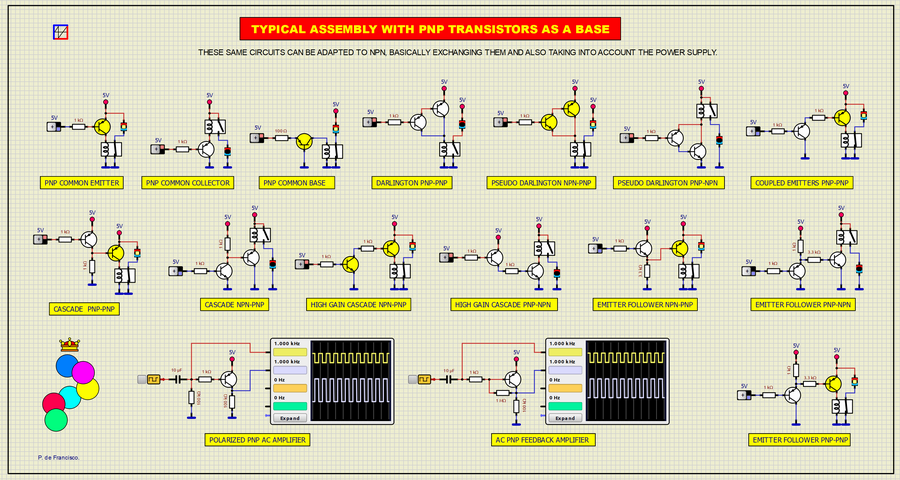348__TYPICAL ASSEMBLY WITH PNP TRANSISTORS
Quote from Defran on November 19, 2023, 10:19 pm
348_TYPICAL ASSEMBLY WITH PNP TRANSISTORS. (Simulide R2116 or higher.)
This is a compendium of typical assemblies with PNP transistors. Obviously these are not composed only of PNP, some are also used combined with NPN due to their functioning requirements. In each of them, by pressing its switch you can see its operation.
SCHEME:
Transistors have been used without commercial code and taking into account that their gain is similar. At the output, a relay has been placed whose contacts connect an LED for greater visibility. The typical extracurrent peak absorbing diode has not been placed in antiparallel with the relay winding to simplify the circuits.
SUBCIRCUITS:
This example integrates several subcircuits located in the "data" folder into the ZIP attached. This folder must always be next to the "sim1" scheme so that it can be executed. A subcircuit is a "custom" circuit that accumulates a set of Simulide base components (primitive function) to obtain a new or an adapted function. These subcircuits are treated by Simulide as another component of its own structure. User can create his own subcircuits or use the ones published here in your own designs once the procedure is known, explained in detail in the Simulide tutorials: https://simulide.com/p/subcircuits/
* Communication with the author: Simulide/User/Messages/Defran
P. de Francisco.

348_TYPICAL ASSEMBLY WITH PNP TRANSISTORS. (Simulide R2116 or higher.)
This is a compendium of typical assemblies with PNP transistors. Obviously these are not composed only of PNP, some are also used combined with NPN due to their functioning requirements. In each of them, by pressing its switch you can see its operation.
SCHEME:
Transistors have been used without commercial code and taking into account that their gain is similar. At the output, a relay has been placed whose contacts connect an LED for greater visibility. The typical extracurrent peak absorbing diode has not been placed in antiparallel with the relay winding to simplify the circuits.
SUBCIRCUITS:
This example integrates several subcircuits located in the "data" folder into the ZIP attached. This folder must always be next to the "sim1" scheme so that it can be executed. A subcircuit is a "custom" circuit that accumulates a set of Simulide base components (primitive function) to obtain a new or an adapted function. These subcircuits are treated by Simulide as another component of its own structure. User can create his own subcircuits or use the ones published here in your own designs once the procedure is known, explained in detail in the Simulide tutorials: https://simulide.com/p/subcircuits/
* Communication with the author: Simulide/User/Messages/Defran
P. de Francisco.
Uploaded files: